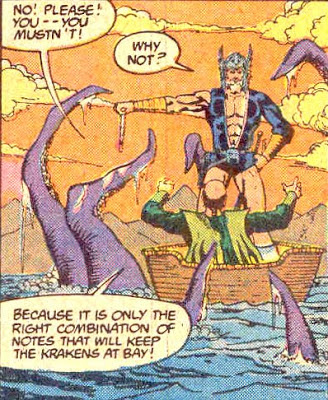Warlord #121 (September 1987)
Written by Michael Fleisher; Pencils by Art Thibert, Inks by Pablo Marcos
Synopsis: Two armies face each other across the Ebondar River. On one side is a contingent from Kaambuka led by General G’Barr, and on the other is a Shamballan force led by Travis Morgan, the Warlord. The armies engage and Morgan moves to avoid bloodshed. He goes straight for the general and defeats him in one on one combat.
Morgan demands to know why the Kaambukans have invaded Shamballan territory. The general accuses them of launching catapult attacks on their capital for 3 days--something Morgan knows they didn’t do. The Kaambukans retreat, leaving Morgan to puzzle over what the hell is going on.
Meanwhile, Kara and Jennifer can’t find the demon. They utilize the history tapes of the Atlanteans to try to find ways to locate the demon and combat him. Turns out:
Azmyrkon had a tripartite rod--”a weapon of unimaginable power.” He wrecked a lot of havoc until Arion showed up to throw a beat down on him and lock him in a prison. He split the demon’s rod into three pieces and hid them.
An earthquake interrupts the ladies’ history lesson and it appears to be an ominous sign.
Morgan is roaming around the desert looking for Tara. He comes across some guys in futuristic gold outfits doing some futuristic stuff with rocks and a launcher. They shoot at Morgan, and he returns fire, knocking one out before he gets knocked out by a rockslide himself.
That gives us a chance to check in on Morgan's CIA nemesis Redmond, who has now undergone full yeti transformation. He’s not about to wait around until the Atlantean snowmen have made enough depilatory for everybody. He stills the antidote and escapes after shooting two of the hairy folk that saved his ungrateful life.
In Kiro, Machiste is being pushed to war on Shamballah by continued reports of raids. He doesn’t buy it, but his ministers are instant. “Tara” is being no help--because she’s really chaos-sowing Y’Smalla disguised by Akolipsian tech.
The real Tara is being kept chained in a dungeon, about to be whipped by a sadistic thug, until:
She eaves him chained to the wall and escapes.
Kara and Jennifer find Azmyrkon causing the Mountain of Dragons volcano to erupt so he can get the first peice of his weapon. Our heroines take him on, but after a battle they’re only able to escape with their lives. Azmyrkon carries the day.
Morgan finally wakes up from his umpteenth concussion since the start of this series. The guys in the weird outfits are gone--except the one he had grazed. Morgan manages to wake the guy up. Before Morgan even thinks about harsh interrogation techniques, the guy begins to panic and warns Morgan to stay away
Elsewhere, a cackling Desaad watches the scene on a console. He presses a button and the man disintegrates before Morgan’s eyes.
Things to Notice:
- Unlike Morgan and Machiste, Ashir, King of Kaambuka, doesn't lead his armies from the front.
- Redmond (yet again) takes his quest for revenge too far.
- Y'Smalla didn't have very good security on Tara.
Where it Comes From:
Here we have the first appearance in story in Warlord of Arion, Lord of Atlantis.
Jerry Bingham's cover for this issue recalls Frank Miller's cover for Daredevil #189 from 1982:
Here we have the first appearance in story in Warlord of Arion, Lord of Atlantis.
Jerry Bingham's cover for this issue recalls Frank Miller's cover for Daredevil #189 from 1982:























.jpg)
























.jpg)








